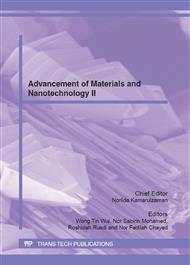p.335
p.342
p.348
p.355
p.359
p.367
p.373
p.379
p.387
Bio-Inspired Advanced Materials for Reducing Friction & Wear in MEMS Devices
Abstract:
Micro-Electro-Mechanical-Systems (MEMS) are miniaturized devices built at micro/nano-scales. At these scales, friction force is extremely strong as it resists the smooth operation and reduces the useful operating lifetimes of MEMS actuator devices. In order to reduce friction and wear in MEMS devices, we have undertaken a bio-inspired approach by applying the underlying principle of the “Lotus Effect”. Lotus leaf surfaces have small-scale protuberances and wax covered on them, which make the surfaces water-repellent in nature. By creating textured surfaces that mimic these bio-surfaces, surface energy and contact area can be reduced. This in turn reduces friction force and eventually increases the wear durability of surfaces. In our work, we have fabricated bio-inspired surfaces that resemble the texture on lotus leaf. The method includes oxygen plasma treatment of polymeric thin/thick films and application of a nanolubricant namely, perfluoropolyether (PFPE). When this method was applied to SU8 polymer thin/thick films spin coated on silicon wafers, friction reduced considerably, and simultaneously the wear durability increased by >1000 times. The method is time and cost effective, and is commercially viable.
Info:
Periodical:
Pages:
359-363
Citation:
Online since:
July 2012
Keywords:
Price:
Сopyright:
© 2012 Trans Tech Publications Ltd. All Rights Reserved
Share:
Citation:


